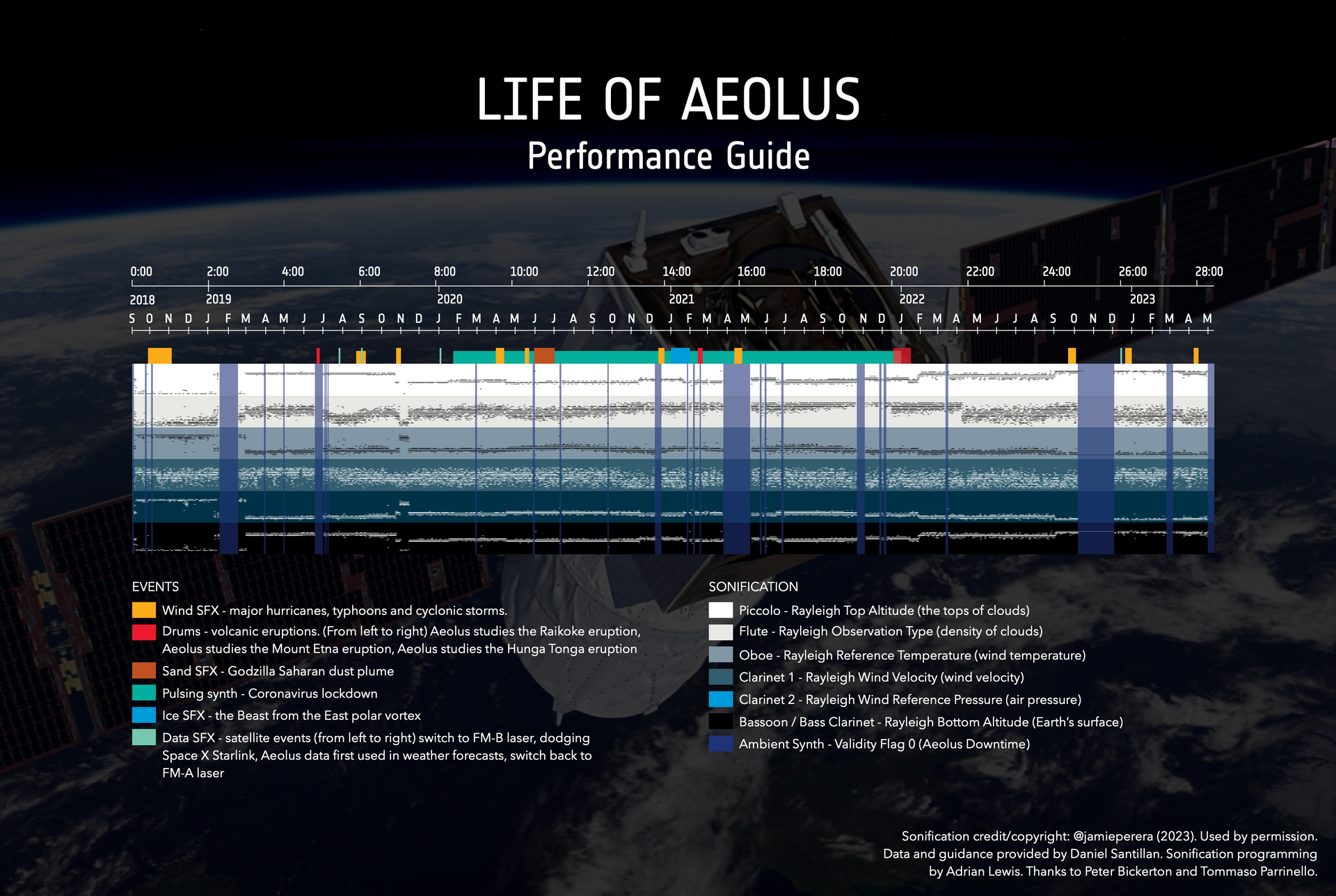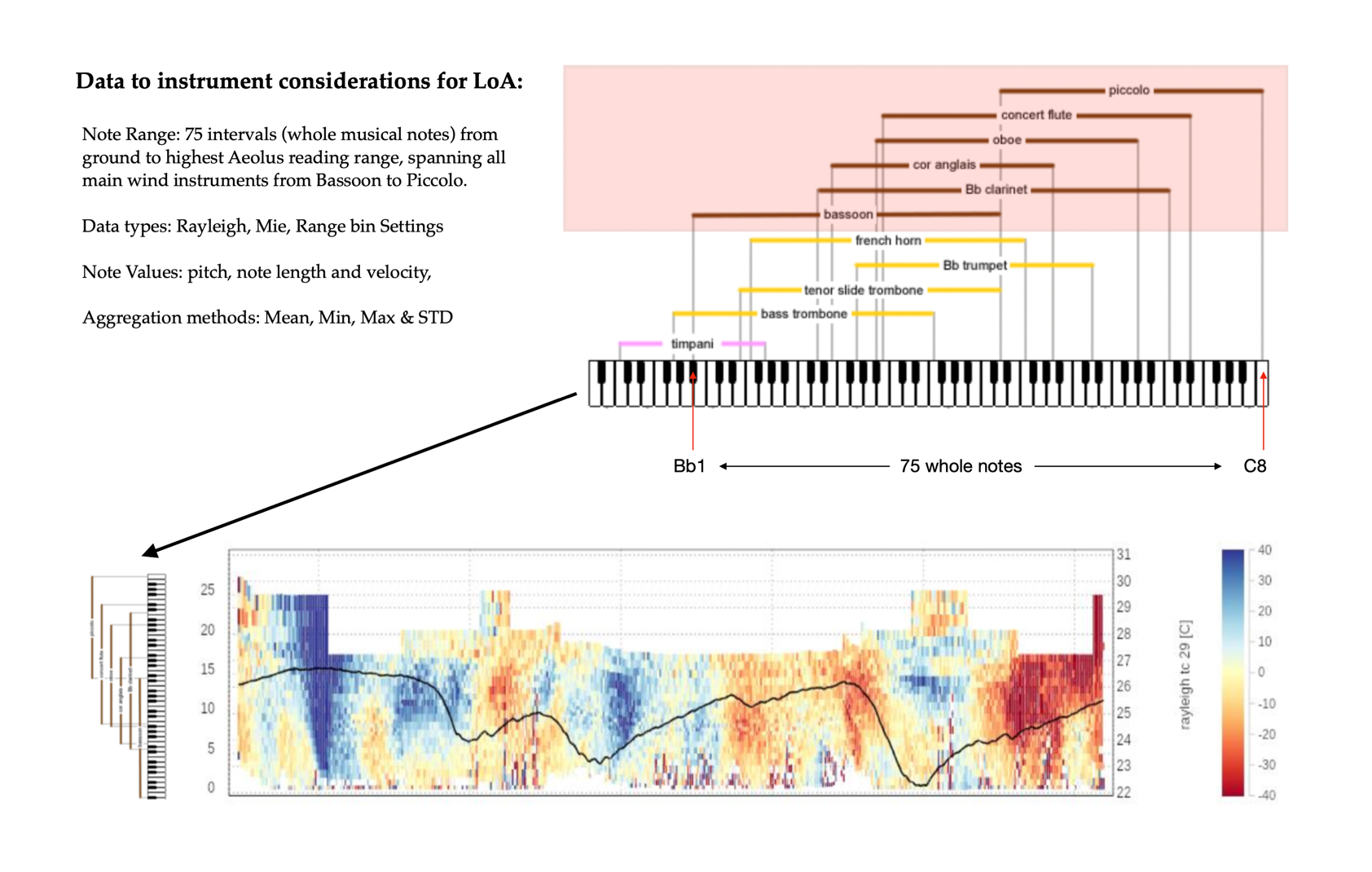Life of Aeolus
Sonification of Aeolus satellite data with Orchestral Wind instruments | European Space Agency
Aeolus is one of the European Space Agency’s most pioneering satellites, which burned up on re-entry over Antarctica on the 28th July 2023. To commemorate its return to earth, ESA commissioned Jamie Perera to tell the story of Aeolus’s life through data made into a modern classical piece for woodwind. The resulting piece has been described by Josef Aschbacher, ESA Director General, as "one of the most incredible expressions of science I've seen", and had over 500k engagements on social media. A dedicated, first of its kind sonification project for the Aeolus mission, highlighting some of the many world events that have happened along the way, such as volcanic eruptions, the coronavirus pandemic, and huge Saharan dust events, captured in time.
Composed and produced by Jamie Perera
Sonification programming by Adrian Lewis
Data processing and aggregation by Daniel Santillan (EOX)
Film directed by Eric Trometer,
Film produced by Eric Trometer, Jamie Perera, Peter Bickerton & Tommaso Parrinello
Concept development by Peter Bickerton and Jamie Perera.
Links:
ESA article - The sound of Aeolus will blow you away
EJR Quartz article - Finding the sound of Earth’s winds
Audio:
Performance guide:

Sonification information:
Timing:
In the 30 minute piece, each second is a day in the life of Aeolus – and the wind it measured as it orbited the globe 16 times a day.
Global tuning:
After careful consideration and experimentation with a few different modes, we chose Lydian mode with the root note of Bb (the lowest note played by an instrument at the moment is Bb1 on bassoon). We felt that the loss of accuracy moving from the chromatic scale to lydian mode was outweighed by the increase in accessibility, and would benefit listeners in terms of ear fatigue when listening to the whole piece.
Data to instrument considerations:

Data choices and assignments to instruments:
| Data | Instrument | Midi Parameter | Notes |
|---|---|---|---|
| Mean Rayleigh Wind Top Altitude | Piccolo | Note value (pitch) | The tops of clouds seemed suitable for the highest instrument in the woodwind section. |
| STD Rayleigh Wind Top Altitude | “ | Velocity value (how hard note is played) | “ |
| MIN Rayleigh Wind Top Altitude | “ | Note length (how long the note is played) | “ |
| Mean Rayleigh Wind Observation Type | Flute | Note value (pitch) | This is a value of how cloudy it is, feels to be high, but not as high as piccolo - therefore flute chosen |
| STD Rayleigh Wind Observation Type | “ | Velocity value (how hard note is played) | “ |
| STD Rayleigh Wind Observation Type | “ | Note length (how long the note is played) | “ |
| Mean Rayleigh Wind Reference Temperature | Oboe | Note value (pitch) | Seems to complement wind velocity and pressure |
| STD Rayleigh Wind Reference Temperature | “ | Velocity value (how hard note is played) | “ |
| MIN Rayleigh Wind Reference Temperature | “ | Note length (how long the note is played) | “ |
| Mean Rayleigh Wind Velocity | Clarinet 1 | Note value (pitch) | Seems an important core data type. Clarinet is a strong dependable core woodwind instrument |
| STD Rayleigh Wind Velocity | “ | Velocity value (how hard note is played) | “ |
| MIN Rayleigh Wind Velocity | “ | Note length (how long the note is played) | “ |
| Mean Rayleigh Wind Reference Pressure | Clarinet 2 | Note value (pitch) | Seems an important core data type. Clarinet is a strong dependable core woodwind instrument |
| STD Rayleigh Wind Reference Pressure | “ | Velocity value (how hard note is played) | “ |
| MIN Rayleigh Wind Reference Pressure | “ | Note length (how long the note is played) | “ |
| Mean Rayleigh Wind Bottom Altitude | Bassoon & bass clarinet | Note value (pitch) | The height of the earth at time of reading seems apt for the lowest ranged instrument e.g. bassoon. Reinforced with Bass clarinet |
| STD Rayleigh Wind Bottom Altitude | “ | Velocity value (how hard note is played) | “ |
| MIN Rayleigh Wind Bottom Altitude | “ | Note length (how long the note is played) | “ |
